
…for me to poop on!
(Spotted@ 16th/Mission BART.)

…for me to poop on!
(Spotted@ 16th/Mission BART.)
Clearly, the stingray is the star of this video, as it should be. The cruel, matter-of-fact way that the fisherman handles it doesn’t seem to lessen its sinister awesomeness.
Perhaps it’s a good symbol for this whole area of San Francisco.
This video covers Candlestick Point, Yosemite Slough, South Basin, and India Basin. Stay tuned as we explore the entirety of San Francisco’s coastal edges in an ongoing series of vids.

View Spots Unknown Map in a larger map
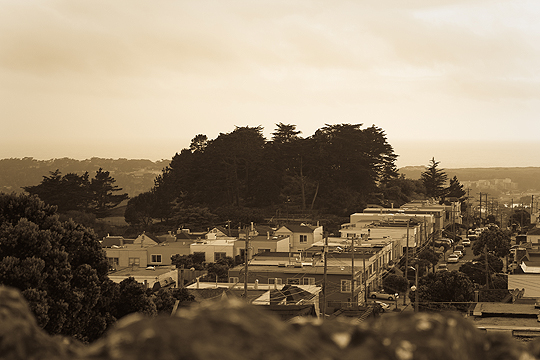
Not long ago it was a post-apocalyptic den of drug abuse, blood sport, and murder. Now, it has been re-made as a virtual Valhalla by The Mad Viking himself, Peter Vaernet, and is a tribute to the past figures who battled to make something noble out of the parcel of land atop Merced Heights.
Today, Brooks Park is a model for creative land stewardship, urban gardening, and community pride.
Peter Vaernet is a cyclone of positive energy, and has swept folks like gardener John Herbert into the storm. Together they’ve completed the park’s dramatic adventure from its auspicious beginnings with the Brooks family in the 1930s, through its 1970s and 80s descent, to its glorious present rebound.
We took our camera into the fog to Brooks Park last weekend while they were building a temporary tomato greenhouse in the garden, and met Peter and John:
Victory of the Mad Viking, San Francisco from Spots Unknown on Vimeo.
More after the jump…
Continue reading Victory of the Mad Viking: Brooks Park
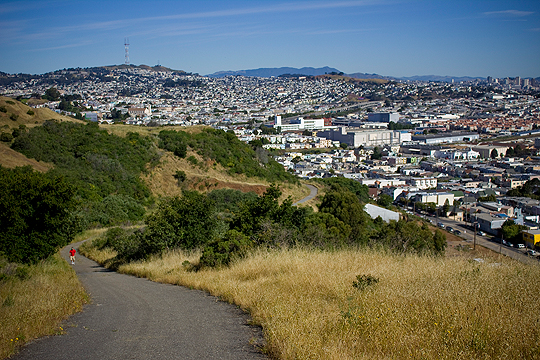
With the mild renaissance of Candlestick Point Recreation Area, you’d think there would be more interest in the conspicuous hill that juts up from the far side of the football stadium. It’s called Bayview Park (or Bayview Hill, alternatively), and it sacrificed its eastern slopes in the 1950s as fill on which to plant the arena.
It has suffered from neglect and harsh urbanization throughout its history, and it it’s barely appreciated even now by San Francisco residents, despite its natural beauty and kickass vistas. But it is getting attention by some for its high diversity of native plant species, including coastal scrub, oak groves, and the largest population of rare Islais cherry trees around.
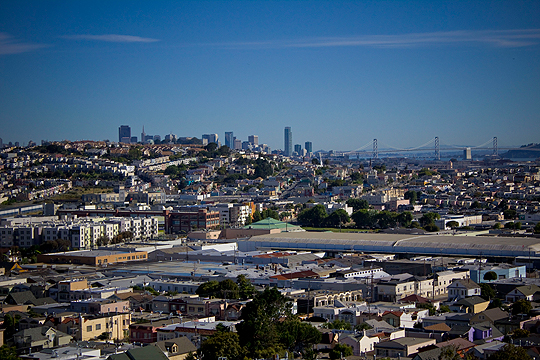
There are also a number of area and migratory birds that frequent the hill; I spotted a big, fat Horned Owl when I went last weekend.
I also went off-trail a bit and discovered the ruins of a makeshift structure:
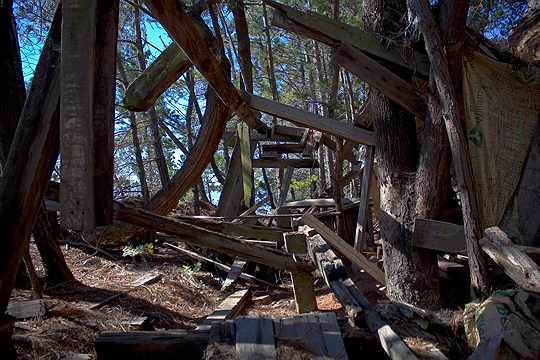
I don’t know if it was a kid’s fort or a homeless encampment, but it was cool. I’m not gonna tell you exactly how to find it – because what fun would that be? – but if you decide to go looking, be sure to wear shoes with some tread.
For anyone who claims to be fan of SF’s hilltops, this spot simply must be visited and explored.
View Spots Unknown Map in a larger map
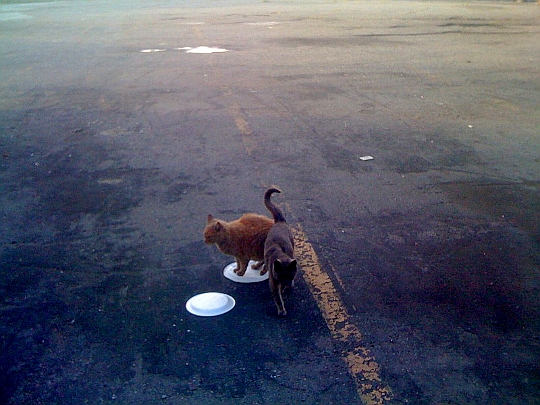
Photo by MrEricSir
This is some pretty funny shit:
They were initially interested in me, but when I failed to produce food they got into some civil unrest over who got to sit on which paper plate.
(More pics @)
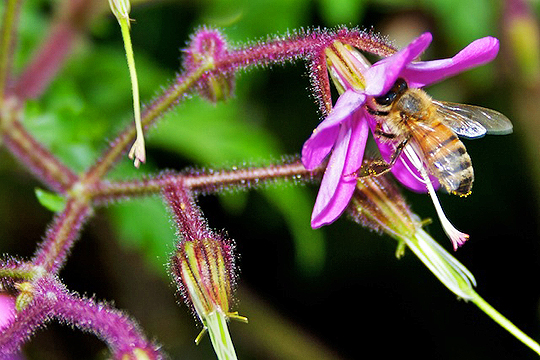
Of all the ghosts haunting Golden Gate Park, the most frustrated might be John McLaren.
When McLaren died in 1943 at the age of 96, he’d served as Golden Gate Park superintendent for 52 years, during most of which he lived in the stately lodge at Stanyan and JFK. His was a life distinguished by a devotion to trees and a hatred of statuary – so how did they mark his passing? With a statue, of course.
You might’ve spotted it on a walk through Golden Gate Park. He’s the short man gazing at a pinecone, not far from the weekend roller-skaters.
That statue is more than just a commemoration of McLaren’s decades of work on the park, which was no more than a strip of sand dunes when first entrusted to his care in 1887. It also marks the entrance to the John McLaren Memorial Rhododendron Dell, which has been closed since mid-2009, only just re-opened this month.
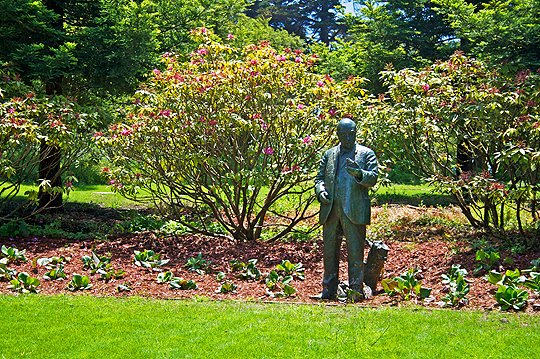
The revamped dell seems strangely empty at the moment, since most of the new plantings haven’t had an opportunity to grow in yet. Over the summer, the beds will become much more lush.
Until then, it’s still a lovely place to wander and get lost. Highlights include a winding staircase to a shaded mound with out-of-the-way benches, and various interesting narrow unpaved paths that lead up into the hillsides.
This facelift for the dell is just the latest upgrade in a difficult history. Created in the early 1950s, many species initially died. As more appropriate varieties of rhododendron were planted, the dell began to fill in – only to be decimated in the same 1996 storm that nearly destroyed the Conservatory of Flowers. Various rehabilitation projects have struggled to keep the dell healthy since then.
But it’s not as easy as simply planting a bush in the ground. A number of factors work against the success of rhododendrons in Golden Gate Park: direct sun can burn the plants to death, while strong winds can inhibit the flow of nutrients.
A 1955 article in the Journal of the American Rhododendron Society adopts an exasperated tone when discussing the failed plantings in the dell:
All rhododendrons are not for all people. Reluctantly we are forced to agree with many who have tried before us that the R. griersonianum hybrids are not going to live up to their rating in the San Francisco Bay area. We refused to accept the judgment passed on them and worked up a large stock of many varieties. These were placed in every conceivable location and condition that we could provide. The results have been far from satisfactory.
The article goes on to describe the meticulous breeding of various colorfully-named Rhododendron cultivars, including the R. Van Nes Sensation, R. Fastuosum Flore-plenum, and R. Prof. Hugo De Vries.
Interestingly, one of the few species of rhododendron to thrive in the dell was a clone named R. John McLaren. The ARS article praises the species’ “legginess.”
Today, GGP gardeners are able to ensure healthy vegetation in the dell. Over the next few weeks, the one-time sand-dunes will fill in considerably with blooming rhododendrons – an utterly fitting tribute to the park’s greatest steward.
Matt Baume is a San Francisco writer and photographer covering transit, ecology, and the science of cities.
View Spots Unknown Map in a larger map

“Nothing in the world is more flexible and yielding than water. Yet when it attacks the firm and the strong, none can withstand it, because they have no way to change it.” –Lao Tzu
There’s something about San Francisco’s bodies of water that people just can’t resist. We abuse them, we bury them, we fill them in with rubble and toxins – and then finally when we realize the error of our ways, if we’re lucky we can pull them back from the brink.
Consider Yosemite Creek, a small but crucial part of the city’s watershed. The creek’s entire trip, from McLaren Park to Bayview, takes place in aging underground pipes. But it may not always be that way: the Public Utilities Commission is exploring nifty new ways to “daylight” the creek, ranging from creating new parks to placing watery channels alongside city streets.
The Marsh
Poor McLaren Park. It has a name, but sometimes it seems to lack an identity. Way out in the Excelsior – or is it Portola? – it boasts a head-spinning array of amenities: tennis and basketball courts, a pool, dog run areas galore, barbecue pits and an amphitheater, woodsy trails, and possibly soon a disc-golf course.
But among the Park’s distinguishing features, a spot called Yosemite Marsh may be the most unique. Unlike two nearby asphalt-contained bodies of water – one a reservoir, the other McNab Lake – Yosemite Marsh is a naturally-occurring wetland.
You could be forgiven for walking right by without noticing it. It’s small, and hidden by a thicket of trees. A wooden footbridge crosses through the thicket, spanning a thin gully. Nearby, and for no discernable reason, a concrete sculpture of a dolphin sits across from an always-empty park bench.
At this time of year, the creek is nearly completely dry; but during the rainy season, a steady stream of water emerges from the hillside to feed the marsh. The marsh, in turn, provides habitat to herons, quail, ducks, bullfrogs, lizards, and (thrillingly) wrentits.
Formerly a bit run-down, the Marsh enjoyed an extreme makeover in 2006 [PDF]. The most prominent upgrades are a nice footpath and seating, but there are more infrastructural improvements under the hood: erosion control, enlarged banks, and enhanced wetland plantings, thanks to a $150,000 grant and $150,000 in Rec & Park Department Funds. With riparian rehab projects such as this, it can take five to ten years for plants to mature; the hillside above the marsh still looks a bit scraggly, but you can definitely see where it’s growing in.
Hal Phillips put together this very “electric” edit of footage we shot recently at the marsh:
There’s still lots of work to be done elsewhere in the park. McLaren is currently in the running for a $30,000 grant from Sears (yes, Sears) to improve a particularly unkempt northern entrance to the park.
Of course, the marsh isn’t the only moisture in the area. Various trickles of water can be found throughout the park. (And in fact, I carelessly stepped into one up to my ankle when I visited after a rainstorm.) Why is McLaren so wet? Bedrock. Soil is slow to discharge moisture, so water tends to hang around a bit.
And when the water finally does trickle out of the park, it has quite a trip ahead of it. From McLaren, it winds its way underground past University Mound Reservoir under Portola and the Phillip Burton Academic School, under the 101 and the 3rd Street light rail, and then finally aligning itself with Yosemite Ave – its namesake – before emptying into the South Basin in an area known as Yosemite Slough.
The Slough
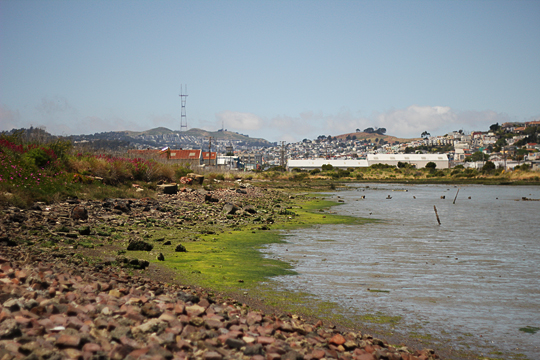
The most complicated step in Yosemite Creek’s journey lies at the very end, in Yosemite Slough. It’s a highly sensitive ecological area, decimated by decades of heavy industry. But there’s reason for hope: a massive environmental restoration is underway [PDF], featuring the planting of thousands of native species, soil remediation, and habitat construction.
But it is only hope at this point. As the video below shows, the area is currently an industrial dumping area. (The song is “33” by David Molina’s Ghosts and Strings.)
It’s not exactly an easy spot to access, and lord knows it’s toxic in several different ways; we’ve done the exploring so you don’t have to.
The Slough is part of Candlestick Point State Recreation Area, which in general is well worth a visit. Don’t let the unseemly history scare you off. Yes, legend has it that it got its name because of all the burning abandoned ships nearby. And yes, for years it was used as a landfill. Okay, and the Navy didn’t exactly take great care of it during WWII.
But! You can’t beat that view. And apparently the birds agree: there’s no better place in San Francisco for spotting herons, loons, egrets, and avocet than nearby Heron’s Head Park. Environmental cleanup – much of it led by students – is gradually turning the area from a garbade dump to prime real estate.
With Yosemite Marsh stronger than ever, Yosemite Slough on the mend, and Yosemite Creek facing a new lease on life, there’s never been a better time to thank San Francisco’s watershed for sticking with us through thick and thin.
Matt Baume is a San Francisco writer and photographer covering transit, ecology, and the science of cities.
View Spots Unknown Map in a larger map
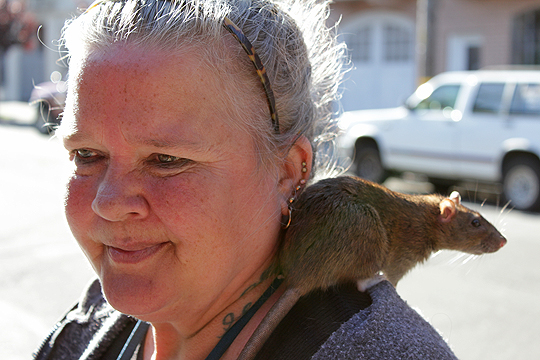
Marlena Vasquez and her pal, Bonita, on 19th at Mission, 8:45am this morning.
![The Birds of Mount Davidson [photo by Jerry Liguori] The Birds of Mount Davidson [photo by Jerry Liguori]](http://spotsunknown.com/wp-content/uploads/2010/04/SharpShinned-Jerry-Liguori.jpg)
Sharp shinned hawk; photo by Jerry Liguori
Last Sunday I took my first steps out of the birder closet. I don’t know where this leads, but I seem to have entered into a vibrant community with a love of bold colors and exaggerated mating behaviors. And, of course, they love to watch. More after the jump…
Continue reading The Birds of Mount Davidson
Without naming the actual hotel involved, CNN opens this article on urban pests with an anecdote about the creator of a website called BedbugRegistry.com getting bitten in San Francisco.
We’re aware of at least one egregious bedbug mating/feeding zone here in the city, but is it fair to highlight SF in the lede that way? Maybe.
There are 497 San Francisco hotels listed on Yahoo Travel, and 64 in The Bedbug Registry‘s database. There are 85 New York hotels found in the registry, but that’s out of 794 total on Yahoo Travel. That gives NYC an infestation rate of 10.7% and SF a rate of nearly 13%.
Now, I realize my method is less than totally scientific. There may be any number of reasons that cause more bug reports in one city than another, and it’s impossible to know the accuracy rate of the reports that are made. For instance, here’s an entry for the Hotel Verona in SF:
Friend seems to have a number of bedbug bites. Other hotel residents had reported them.
Such diagnoses are not exactly confidence-inspiring. Other considerations: There may be hotels in either city not listed on Yahoo Travel, though that effect probably cancels itself out. And, the math is cumulative, so it doesn’t necessarily represent conditions at any given time.
In any case, WTF? The fact that approximately 13% of SF hotels have had bedbug reports is not good. And NYC shouldn’t be bragging about their rate either.
Go ahead and rip apart my math/logic in the comments.
Koko the gorilla was born in the San Francisco Zoo, and is famous for learning sign language. The other thing she’s famous for is keeping pets – namely, kittens.
Below is video of Koko choosing a new pet kitten, donated by the San Francisco Humane Society, on March 10th. But while viewing this sweet scene, I noticed something that has me confused and a little bit concerned.
On YouTube alone, I see reference to at least 3 different kittens (All Ball, Moe, and Tigger), with zero videos of any adult cats.
Kittens are cuter than adult cats, I admit. But if Koko is ruthlessly going through these adorable little fuzzballs like so many living toys, I think that suggests something a lot of us might not be comfortable with.
Like, maybe kittens are as tasty as they are cute?
UPDATE: Eve at SF Appeal informs me of this:
Koko was very gentle with all of her cat friends.. She cared for her
kittens as she would her own tiny gorilla baby, cradling them gently
in her arms and carrying them on her back. She has never harmed them,
even when they scratch or bite, as kittens sometimes do.
Still, that quote reminds me of this:
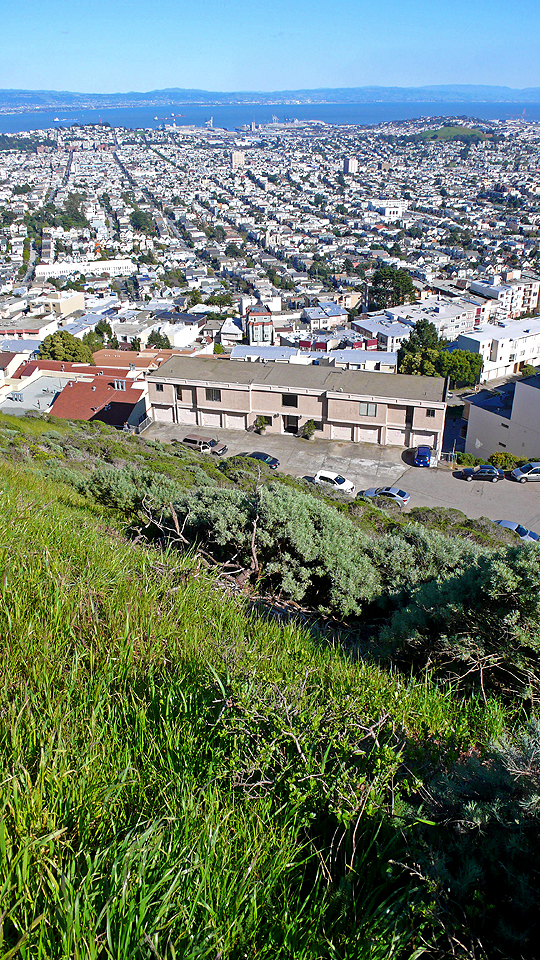
If you’ve got half a day some weekend or holiday, and you like a moderately challenging hike, this easily-accessed, 4.5-mile route with a 900 ft. elevation means you don’t have to leave the city of San Francisco. Details after the jump…
Continue reading Hillapalooza – an Urban Hike
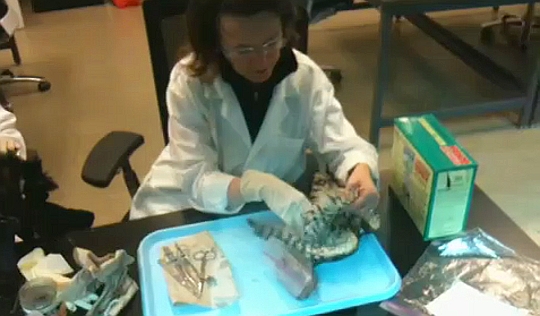
So this happened while in line for the rain forest at the California Academy of Sciences a few weeks back. It was a Thursday “adults only” Night Life event. I guess they’re “treating” a crow and some sort of falcon or small hawk. Video after the jump…
Continue reading Hot, Adults Only Taxidermy Action
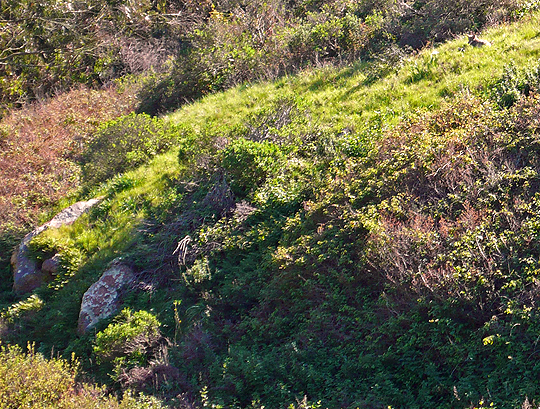
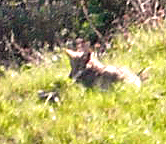
I don’t usually have a need for a telephoto lens, but on Saturday while hiking across some of San Francisco’s biggest hilltops, I spotted a coyote in a park. It made me think more seriously about moving beyond my digital point and shoot camera, to SLR, with at least one good telephoto lens.
So, with tax refund season upon us, I guess I’m in the market for a <$1k rig. I've been looking at the Canon T1i and the Nikon D5000. Anyone have opinions on one or both of these? Are there other competitors in this class I should be tracking? Let me have it in the comments.
![]()
Captured here in high summer, the sprites of San Carlos alley begin to emerge in late spring, just off 19th Street. These photonic flowers only bloom in the afternoon when the sun reflects mysteriously off some top-floor windows.
So keep an eye out for these special visitors when winter ends.
The Franciscan Manzanita, a shrub thought to have been made extinct when its habitat in the SF cemeteries of old was eradicated, has been discovered growing wild near the Golden Gate Bridge. More after the jump…
Continue reading Native San Francisco Shrub – Not Dead Yet!
Why on God’s green earth did anyone dream up this 1938 stunt? To quote the narrator, “Your guess is as good as mine.”
This poor horse chased a handful of sugar and towed a fat, useless human named “Shorty Roberts,” as it swam the Golden Gate just to settle a bet about whether horses can swim:
The swim took 23 minutes and 15 seconds—an hour less than it had taken an Olympic swimmer. When Blackie and Shorty arrived in SF, the SPCA was waiting, but admitted that Shorty looked much worse than the horse and didn’t cite him. Shorty always insisted that the horse loved swimming in the bay.
Sure he did, and why not?
(Spotted@)
Recommended book: Historic Photos of San Francisco
I guess I’ve been a little behind in the city’s coyote news. I know of its presence in the Presidio, Golden Gate Park, Glen Park, and Bernal Hill, sometimes with lethal consequences. But until my girlfriend gave me a small self-printed booklet from (of course) Dog Eared Books, I was unaware that there was a coyote on Twin Peaks.
Aside from the author’s account, I’ve been unable to find any mention of this urban canine carnivore. Have you seen it? Can you point to any online resources about it? I hope it has fared better than some of the others.
And, if you get a chance, don’t miss the KQED special, “Wild at Heart,” about SF’s urban wildlife. Here’s a trailer from a derivative DVD:
Hey, clueless Twitter guy who works at the zoo, not only are you a big doofus, but that “third eyelid”? When the penguin winks it, that means he knows you stole the idea from him. Watch your back at feeding time. Payback’s a bitch.